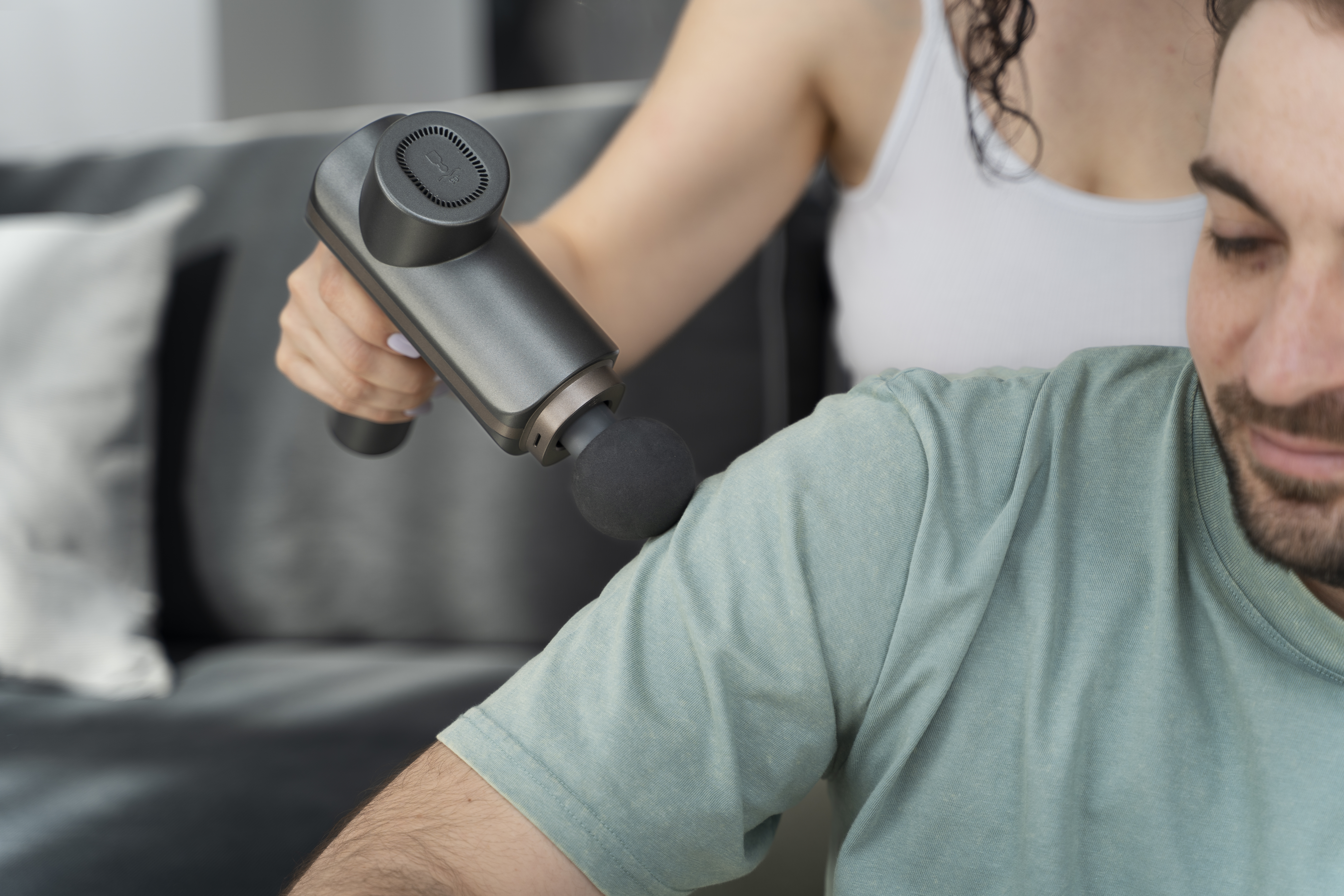October 6, 2023 by Fuel & Fortify
Massage Gun Therapy: Luxury Indulgence or Recovery Essential?

The dreamy allure of a professional massage at the end of every session or even every week is something most of us fantasise about. The ultimate luxury of expert hands working away the knots and tensions from our tired muscles. It’s a recovery indulgence that remains a distant dream.
Thankfully, rapid advancements in technology have birthed a solution that bridges the gap between luxury and necessity—recovery tools such as massage guns that are a form of what’s called percussive therapy (PT). These convenient, compact and portable machines have swiftly become the go-to choice for athletes, fitness enthusiasts, and even everyday individuals seeking effective and accessible recovery solutions—and we look into if they are truly the future of post-workout recovery.
Massage guns have been in the market for a while, but their popularity has surged recently, thanks to partnerships with elite athletes such as LeBron James and social media influencers like Logan Paul. These endorsements, often supported by their testimonials, enthusiastically praise these devices for their recovery benefits. But are their claims legitimate?
There are high-end options like Theragun, akin to Apple’s premium products, while more affordable alternatives have flooded platforms like Amazon for budget-conscious buyers. At their core, these devices all serve a similar purpose—delivering force through various attachments designed to target specific body parts, all adjustable to different speeds.
Already a prominent market in the fitness industry, it’s set to surpass USD $550 million, with an expected annual growth rate of 10% by 2028.
Percussive Therapy
Frequency and Amplitude
We’re talking here about the number of pulses per minute (PPM) the massage gun delivers. Higher frequencies are generally better for muscle relaxation. While amplitude signifies how deep the massage gun’s head moves back and forth. Deeper amplitude can reach and relax deeper muscle tissues.
Attachments and Heads
Different attachments target specific muscle groups or provide different types of massage experiences. Common attachments include flat heads for overall use, bullet heads for trigger points, and ball heads for larger muscle groups.
Noise Level
Some massage guns can be noisy, which might disturb others or be uncomfortable for the user. Quieter models are generally more expensive but offer a more pleasant experience.
What the Science Says
Acknowledging the lag in research when new technology emerges, it’s evident that studies often trail behind product launches by a few years. A 2020 study focused on a 5-minute handheld percussive massage treatment for calf muscles, specifically examining the range of motion (ROM) and muscle performance (MVC) of the plantar flexor muscles, a key group within the calf.
Remarkably, the 5-minute massage led to an 18% increase in ROM, surpassing the control group’s 5%. Similar to conventional massage, massage guns enhance ROM by reducing muscle compliance, increasing blood flow, reducing pain perception, and promoting relaxation.
A recent comprehensive meta-analysis, spanning studies from 2019 onwards, delved into the impact of percussive therapy (PT) on muscle strength, explosive strength, flexibility, and pain experiences.
The findings revealed:
- Limited studies show positive effect of PT on upper body muscle strength (particularly post-op rehabilitation); lower body strength evidence inconclusive.
- Flexibility improvements comparable to static stretching.
- PT reduces musculoskeletal pain and may indirectly enhance flexibility.
- PT can play into the Gate Control Theory of Pain by activating specific nerve fibers, triggering an analgesic effect and thereby reducing the sensation of pain
An interesting discovery revolves around its impact on Delayed Onset Muscle Soreness (DOMS), an important factor for endurance athletes incorporating strength training into their routines—and who will want to bolster their recovery between sessions.
This study revealed that both vibration therapy and massage therapy are equally effective in preventing DOMS. Whilst traditional massage excels in restoring concentric strength from 1 Rep Max efforts, PT demonstrates early pain reduction and effectively lowers LDH (Lactate Dehydrogenase) levels within 48 hours after exercise.
LDH is an enzyme found in many body tissues, including the muscles. LDH levels in the blood can be used as a marker to assess muscle damage or injury.
Best Practices for Usage
-
Start low: Higher intensity doesn’t always mean a better massage. It’s advisable to often begin at the lowest setting and gradually increase intensity
-
Glide it: Allow the massage gun to gently float over the muscle area, without feeling like you have to “dig in” like you traditionally would with your thumbs
-
Avoid Bones: Constant motion is key; avoid bones and focus on larger muscle groups
Summary
Percussive therapy through massage guns epitomise luxury, represents a potentially lavish approach to recovery. While massage guns often come with a high price tag, overall the current research proves their efficacy, dispelling any notion of them being mere gimmicks.
Certainly, for those accustomed to regular massages, it becomes a financially savvy option in the long run, although a slight compromise in quality or benefits might be anticipated.
But outside that, if LeBron swears by it, then it should be good enough for most!